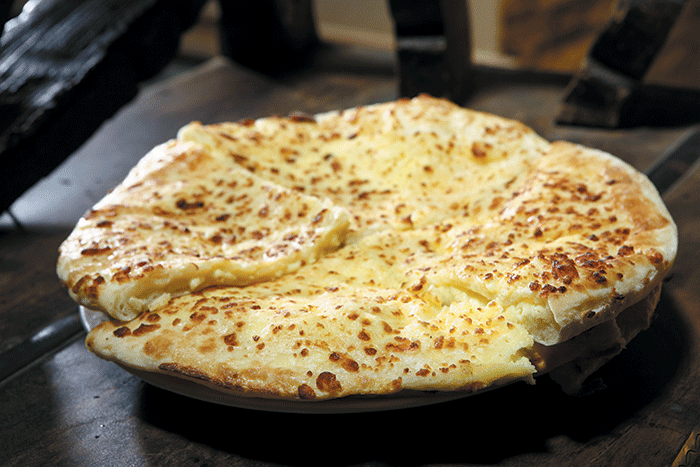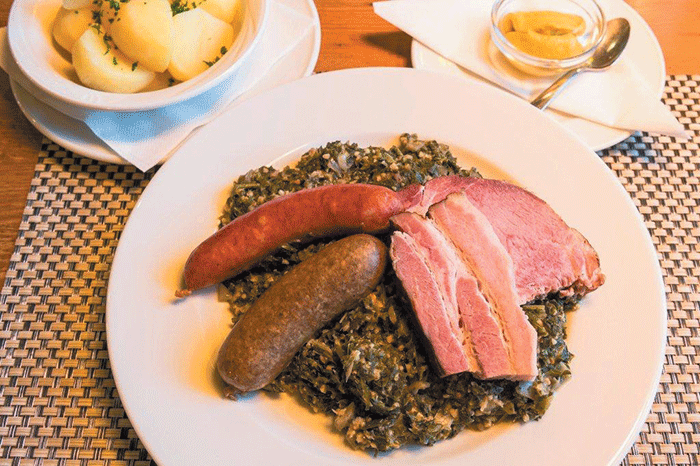To be introduced at the Namyangju Snow Food & Life Expo
The Korea Post introduces the representative foods of all the different countries of the world by publishing them on all its five media units to be eventually introduced to an estimated half a million visitors to the Namyangju Slow Food & Life Expo slated in the month of October this year.
The recipes and explanations and other comments of the representative foods of each country will be published by the three media units in the English language and in the two Korean-language media units in the order of their arrival at the Editorial of The Korea Post. Here are the representative foods of the different countries so far submitted:


Khachapuri (cheese bread) of Georgia
Khachapuri is a filled bread stuffed with melting cheese and often served sliced, like a double-crust pizza. It is justifiably considered to be one of Georgia’s national dishes and is popular in restaurants and in homes.
Ingredients
dough (yields 2 round khachapuri of 8-inch diameter)
105 ml plain whole milk yogurt
1 egg
220 gr flour, sifted
2.5 g salt
6 g baking powder
48 gr butter, soft dough (see above)
225 gr fresh mozzarella
170 gr Greek feta black pepper, ground salt
1egg yolk
30 ml water
Directions:
1. To make the dough: Place the yogurt and egg in the bowl of an electric mixer fit with the paddle attachment. Add about 2/3 of the flour with the salt and baking powder, and mix on medium speed until homogeneous.
2. Add the butter and the rest of the flour, and mix again. Remove the bowl from the mixer, and knead the dough by hand for about one minute. Cover with plastic wrap, and refrigerate for 30 minutes.
3. To make the khachapuri: Divide the dough into 2 equal balls.
4. Preheat the oven to 450, and place a dish full of water on the bottom rack.
5. Slice the mozzarella and feta. In a bowl, crumble both cheeses between your fingers.
6. Season with black pepper, and adjust the salt level if necessary-the mixture should taste quite salty, but still be edible!
7. On a floured surface, roll each ball of dough into an 8-inch diameter disc (a perfect shape isn? very important at this point). Place the cheese mixture in the center, then wrap the dough around it, just like you would wrap something in a handkerchief. Flip the dough over, and gently roll each khachapuri back into an 8-inch diameter disc. Alternately, you can wrap the dough around the cheese mixture like a purse, cut the top, and roll each khachapuri without flipping it. (It? OK to keep some cheese uncovered in the center.)
8. Transfer the khachapuri to a baking sheet lined with parchment paper or a Silpat. Mix the egg yolk and water in a cup, and brush the dough with the resulting egg wash.
9. Bake in the oven for 18-20 minutes, until the top is golden brown. Let cool 5 minutes, then slice and serve.

Curly-Leafed Kale with Smoked Sausage and Salted Smoked Pork
Recipe
Ingredients for 6 servings
- 6 "inkles"smoked German blood sausages, about 600g total)
- 1kg of Washed kale, fresh or frozen
- 2 Onions, diced
- Salt
- Pepper
- 3 Table spoons of lard or butter oil
- 600-800ml Vegetable stock
- 300g Bacon, diced
- 800g potatoes, not peeled (side dish)
- 3 Table spoons of mustard
- 3 Table spoons of oat flakes or potato flour
- Optional: nutmeg, caraway, sugar
Explanations:
If using fresh Kale, start with cooking kale in salt water for 3-5 minutes. Then put the lard or butter oil in a big pot and melt it. Add onions and bacon and fry until golden. Now add kale, vegetable stock, salt, spices and mustard and let it cook on low temperatures with closed lid for 30 minutes (kale should be squishy). Place the sausages on top and continue to cook on low temperature for another 20-30 minutes (sausages only need to heat). Add the smoked pork on top and let it cook for another 20 minutes. If needed, add more water. While waiting, start to boil the potatoes in salt water for about 20 minutes, peel after. Before serving, add oat flakes or potato flour to thicken the kale. If not bought sliced, slice Kassler now. Enjoy!
Pilau, rice-based dish, KenyaPilauis a rice-based dish of Indian origin that has been adopted by Kenyans as their own. Many people serve Pilauat their weddings or prepare it when they have special guests coming to visit. It is commonly eaten with kachumbari, but you can substitute salad or other vegetable sides for kachumbari.
Recipe
3 TablespoonsPilau Masala (a blend of spices obtainable in Kenya) or make your own by mixing the following spices:
1/2 tsp cumin seeds
1/2 tsp whole black peppercorns
1 Tablespoon whole cloves (not to be confused with garlic) 1 cinnamon stick (or 1/4 tsp ground cinnamon)
1/2 tsp cardamom pods (or 1/4 tsp ground cardamom) 3 cups basmati or jasmine rice
1. 5lb beef, chopped in bite-sized pieces
2 medium onions, chopped (red onions are best) 3 medium tomatoes, diced
2 tsp fresh ginger 6 cloves of garlic
2 Tablespoons cooking oil 1 tsp salt
6 cups water*
1. Combine the spice ingredients in a small bowl, cover with warm water, stir, and set aside. Press or pound the garlic and ginger together and set aside. Wash the rice, drain, and soak for an hour.
2. Heat oil in a dutch oven or deep pot. Add onions and saute until glazed, stirring occasionally. Stir in the garlic and ginger and saute for a minute. If using the Pilau Masala blend, stir in the masala and saute for another couple of minutes. If using the soaked spices, wait to add them a little later.
3. Add the beef, cooking on high heat until browned. Reduce the heat and simmer for 5 minutes. Drain and add the rice to the meat, stirring thoroughly to coat each grain of rice with the oil. Stir in the tomatoes and simmer for a minute. If using soaked spices, mix them with water to make a total of 6 cups of water and add them now. If you added the spices earlier, just add 6 cups of water. Stir, cover and bring to the boil.
4. Reduce to low-medium heat and let simmer, stirring occasionally to prevent it from sticking to the bottom of the pot. Simmer until all the liquid has been absorbed. Remove from stove and serve hot with a side of kachumbari, salad or seasonal vegetables.
Explanations
Pilau is also a Swahili coastal food that is made of rice. Popular at the coastal areas of Kenya. Expensive to make therefore only commonly served in ceremonies like weddings, funerals and other celebrations since it is easier to serve as a single meal for a crowd. It is very delicious.

Nyama Choma, ribs, KenyaIn Kenya, any gathering is an excuse for eating Nyama Choma, Swahili for "oast meat."From the finest restaurants to roadside shacks, roast goat meat is served up as a kind of social lubricant, often aided by copious amounts of the local beer. Nyama Choma is always eaten with the hands, and common side dishes include kachumbari salad and ugali.
RecipeGoat or beef meat, cut into bite-sized chunks -2 pounds Oil
3 tablespoons Warm water, 2 cups Kosher or sea salt, 2 tablespoons
1. Prepare your grill and have it hot.
2. Toss the meat with the oil, and then thread it on skewers. Stir the salt into the warm water until it is fully dissolved.
3. Grill the skewered meat, basting it occasionally with the salt water, until it is cooked to your desired doneness.
4. Remove the meat from the skewers and serve with kachumbari salad

Mandazi, KenyaMandazi is donuts. You can find these delicious donuts in large urban areas and also among the Swahili people of East Africa. Most small restaurants, called hotelis in Kenya, serve mandazi. You can also find mandazi being sold by street vendors.The mandazis are great in the morning for breakfast or at any time of the day. They are normally served with a cup of hot tea or any beverage of choice. Mixing and kneading does not take long and it requires few ingredients.
Recipe
4 cups of wheat flour
1 tablespoon of salt
4 tablespoons margarine/butter
5 tablespoons of baking powder
1/2 cup of sugar
1/2 tablespoon black pepper
1 cup of water/milk
1. Put the black pepper in a small mortar and pound till roughly grounded. 2. Mix the flour, salt, baking powder, sugar and black pepper in a bowl.
3. Use a spoon to add the margarine/butter to the flour mixture and mix well using your fingers. Take some amount of the margarine and run it through the flour mixing the two with your fingers. Do this until all the flour has been mixed with the margarine.
4. Pour in the milk/water into the flour bowl and mix. Knead the dough to a smooth consistency.
5. Let it stand for about thirty minutes then divide the dough into four smaller portions.
6. Add oil to a deep frying pan and bring the oil to high heat.
7. In the meantime apply some flour on a rolling board or flat surface, then using a rolling pin roll out the first dough to a circular shape.
8. Cut the dough into four equal pieces as shown below.
9. Once the oil is quite hot, carefully drop each piece into the pan. Notice as it immediately starts browning on the first side and after two minutes turn it over to cook the other side. Depending on the size of your deep frying pan, you can cook four or more mandazis at the same time.
10. Once both sides are browned, remove from heat and drain on paper towels. k
Send your recipe and explanations to: edt@koreapost.com

